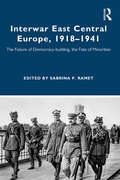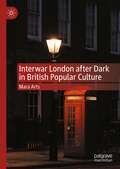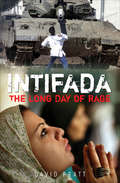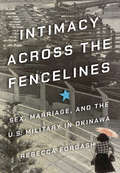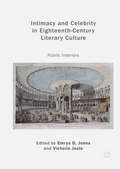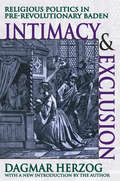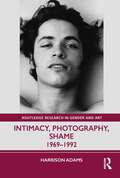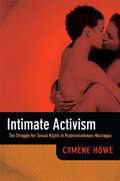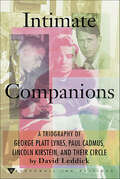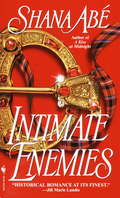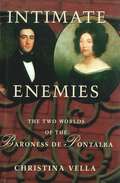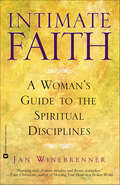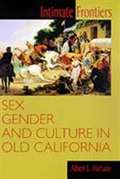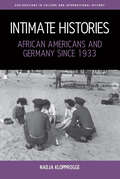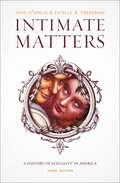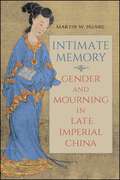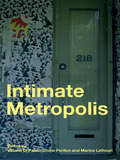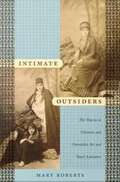- Table View
- List View
Interwar East Central Europe, 1918-1941: The Failure of Democracy-building, the Fate of Minorities (Routledge Studies in Modern European History)
by Sabrina P. RametThis monograph focuses on the challenges that interwar regimes faced and how they coped with them in the aftermath of World War One, focusing especially on the failure to establish and stabilize democratic regimes, as well as on the fate of ethnic and religious minorities. Topics explored include the political systems and how they changed during the two decades under review, land reform, Church–state relations, and culture. Countries studied include Poland, Czechoslovakia, Hungary, Yugoslavia, Romania, Bulgaria, and Albania.
Interwar London after Dark in British Popular Culture
by Mara ArtsThis book explores the representation of London’s nightlife in popular films and newspapers of the interwar period. Through a series of case-studies, it analyses how British popular media in the 1920s and 1930s displayed the capital after dark. It argues that newspapers and films were part of a common culture, which capitalized on the transgressive possibilities of the night. At the same time both media ensured that those in authority, such as the police, were always shown to ultimately be in control of the night. The first chapter of the book provides an overview of the British film and newspaper industries in the interwar period. Subsequent chapters each explore a specific aspect of London’s nightlife. In turn, these chapters consider how films and newspapers of the interwar period depicted women navigating the street at night; the Metropolitan Police’s involvement in nightlife; and the capital’s newly built and expanded suburbs and public transport network. Finally, the book considers how newspapers and films depicted themselves and one another.
Interwar Symphonies and the Imagination: Politics, Identity, and the Sound of 1933 (Music in Context)
by Emily MacGregorThe symphony has long been entangled with ideas of self and value. Though standard historical accounts suggest that composers' interest in the symphony was almost extinguished in the early 1930s, this book makes plain the genre's continued cultural dominance, and argues that the symphony can illuminate issues around space/geography, race, and postcolonialism in Germany, France, Mexico, and the United States. Focusing on a number of symphonies composed or premiered in 1933, this book recreates some of the cultural and political landscapes of an uncertain historical moment-a year when Hitler took power in Germany, and the Great Depression reached its peak in the United States. Interwar Symphonies and the Imagination asks what North American and European symphonies from the early 1930s can tell us about how people imagined selfhood during a period of international insecurity and political upheaval, of expansionist and colonial fantasies, scientised racism, and emergent fascism.
Intifada: Palestine and Israel - The Long Day of Rage
by David PrattArmed with stones, Kalashnikovs, and the scarcely believable martyrdom of the suicide bomber, a generation of Palestinians has confronted one of the most lethal armies in the Middle East in a battle that has stunned and horrified the world. For almost two decades the Intifada has been the byword for Palestinian resistance to Israeli occupation. But, for all its familiar usage in the media, many people remain unclear as to what the Intifada really is, or how it began. Just what fuels the anger? Who are the key players in this deadly clash and where, during these dangerous days in the Middle East, does the resistance go from here? Part reflection, part reportage, in The Long Day Of Rage award-winning foreign correspondent and film-maker David Pratt, takes the reader on a journey across the frontlines of the Palestinian uprising.From the War of the Stones in the 1980s, to the eruption of the al-Aqsa Intifada in 2000, and the ultimate rise of Hamas, this is an eyewitness tour through the Islamic hotbeds, beleaguered refugee camps, and bomb-makers’ dens of the West Bank and Gaza Strip. Above all, it is a gripping and graphic account of a people's struggle to shake off oppression as viewed from the ground zero of besieged Ramallah and the ruins of a shell-shattered Jenin.About the author:David Pratt has been a foreign correspondent and photojournalist specialising in the Middle East, Arab and Islamic world for more than twenty years. He has worked for Reuters, the Institute for War and Peace Reporting (IWPR), and is a regular contributor to the BBC on conflict and foreign affairs issues. During an adventurous career, Pratt has covered wars across the Middle East and Africa, including Israel/Palestine, Iraq, Congo, Sudan and Somalia, and has twice been a finalist in the Amnesty International Media Awards for his reporting on human rights issues. In Afghanistan in 1989 he had the dubious pleasure of having tea and a chat with Osama bin Laden during a lull in fighting around the city of Jalalabad. David Pratt is currently the Foreign Editor of the Sunday Herald.
Intimacy across the Fencelines: Sex, Marriage, and the U.S. Military in Okinawa
by Rebecca ForgashIntimacy Across the Fencelines examines intimacy in the form of sexual encounters, dating, marriage, and family that involve US service members and local residents. Rebecca Forgash analyzes the stories of individual US service members and their Okinawan spouses and family members against the backdrop of Okinawan history, political and economic entanglements with Japan and the United States, and a longstanding anti-base movement. The narratives highlight the simultaneously repressive and creative power of military "fencelines," sites of symbolic negotiation and struggle involving gender, race, and class that divide the social landscape in communities that host US bases.Intimacy Across the Fencelines anchors the global US military complex and US-Japan security alliance in intimate everyday experiences and emotions, illuminating important aspects of the lived experiences of war and imperialism.
Intimacy and Celebrity in Eighteenth-Century Literary Culture: Public Interiors
by Emrys D. Jones Victoria JouleThis book provides an expansive view of celebrity’s intimate dimensions. In the process, it offers a timely reassessment of how notions of private and public were negotiated by writers, readers, actors and audiences in the early to mid-eighteenth century. The essays assembled here explore the lives of a wide range of figures: actors and actresses, but also politicians, churchmen, authors and rogues; some who courted celebrity openly and others who seemed to achieve it almost inadvertently. At a time when the topic of celebrity’s origins is attracting unprecedented scholarly attention, this collection is an important, pioneering resource.
Intimacy and Exclusion: Religious Politics in Pre-revolutionary Baden (Princeton Studies In Culture/power/history Ser. #337)
by Dagmar HerzogIn this pathbreaking work, Dagmar Herzog situates the birth of German liberalism in the religious confl icts of the nineteenth century. During the years leading up to the revolutions of 1848, liberal and conservative Germans engaged in a contest over the terms of the Enlightenment legacy and the meaning of Christianity-a contest that grew most intense in the Grand Duchy of Baden, where liberalism fi rst became an infl uential political movement. Bringing insights drawn from Jewish and women's studies into German history, Herzog demonstrates how profoundly Christianity's problematic relationships to Judaism and to sexuality shaped liberal, conservative, and radical thought in the pre-revolutionary years.In particular, she reveals how often confl icts over the private sphere and the"politics of the personal" determined larger political matters.
Intimacy, Performance, and the Lied in the Early Nineteenth Century (Historical Performance)
by Jennifer RonyakThe German lied, or art song, is considered one of the most intimate of all musical genres—often focused on the poetic speaker’s inner world and best suited for private and semi-private performance in the home or salon. Yet, problematically, any sense of inwardness in lieder depends on outward expression through performance. With this paradox at its heart, Intimacy, Performance, and the Lied in the Early Nineteenth Century explores the relationships between early nineteenth-century theories of the inward self, the performance practices surrounding inward lyric poetry and song, and the larger conventions determining the place of intimate poetry and song in the public concert hall. Jennifer Ronyak studies the cultural practices surrounding lieder performances in northern and central Germany in the first quarter of the nineteenth century, demonstrating how presentations of lieder during the formative years of the genre put pressure on their sense of interiority. She examines how musicians responded to public concern that outward expression would leave the interiority of the poet, the song, or the performer unguarded and susceptible to danger. Through this rich performative paradox Ronyak reveals how a song maintains its powerful intimacy even during its inherently public performance.
Intimacy, Photography, Shame: 1969–1992 (Routledge Research in Gender and Art)
by Harrison AdamsThis study argues that intimacy requires an overcoming of shame, and each of these artists, in their own way, uses photography to frame moments that can be shameful to some and intimate others, leaving it to the viewer to navigate this affectively perilous terrain.From the cancellation of Mapplethorpe’s retrospective The Perfect Moment to the obscenity trial in Cincinnati shortly thereafter, to Hujar’s lesser-known but equally “hardcore” imagery, to Goldin’s gritty depictions of domestic violence and substance abuse, to the accusations of child pornography thrown at Mann’s photographs of her own children, the photographers at the heart of this book have probed the limits of acceptability. But there is more to their work than merely controversy; it’s what causes the controversy that matters. The notion of intimacy is at stake in some of our most important human relationships, and thus a great deal hinges on both achieving and preserving intimacy.This book will be of interest to scholars working in art history, photography and gender studies.
Intimate Activism: The Struggle for Sexual Rights in Postrevolutionary Nicaragua
by Cymene HoweIntimate Activism tells the story of Nicaraguan sexual-rights activists who helped to overturn the most repressive antisodomy law in the Americas. The law was passed shortly after the Sandinistas lost power in 1990 and, to the surprise of many, was repealed in 2007. In this vivid ethnography, Cymene Howe analyzes how local activists balanced global discourses regarding human rights and identity politics with the contingencies of daily life in Nicaragua. Though they were initially spurred by the antisodomy measure, activists sought to change not only the law but also culture. Howe emphasizes the different levels of intervention where activism occurs, from mass-media outlets and public protests to meetings of clandestine consciousness-raising groups. She follows the travails of queer characters in a hugely successful telenovela, traces the ideological tensions within the struggle for sexual rights, and conveys the voices of those engaged in "becoming" lesbianas and homosexuales in contemporary Nicaragua.
Intimate Betrayal
by Adrienne BassoThe author of Every Bit a Rogue delivers a Regency romance that &“builds sexual tension to a satisfying crescendo. This book sizzles with desire&” (Literary Times). Fiercely independent Alyssa Carrington deftly ran her father&’s English estate for years. But before his death, he auctioned Westgate Manor to the highest bidder, leaving her penniless. Now there was a new lord of the manor—and Alyssa found herself at his mercy . . . A charismatic ladies&’ man, the Duke of Gillingham is more than happy to welcome lovely Alyssa into rooms that were once hers—especially the master bedroom. Never before has he met a woman who so attracts him body and mind. But it is exactly Alyssa&’s mind that concerns her. Much as she enjoys the Duke&’s attentions, she does not enjoy the longing he inspires. Nor will she become another of his conquests. Yet the Duke has powers of persuasion Alyssa never dreamed possible. Now she must decide whether to risk her sensibly planned future—and her sensibly guarded heart . . . Praise for the novels of Adrienne Basso &“Basso has a gift for creating stories tinged with simmering passion and poignancy.&” —Romantic Times &“Sinfully sensual.&” —Booklist &“Delightful . . . This rousing romance will enchant series fans and win over new readers.&” —Publishers Weekly
Intimate Bonds: Family and Slavery in the French Atlantic (The Early Modern Americas)
by Jennifer L. PalmerFollowing the stories of families who built their lives and fortunes across the Atlantic Ocean, Intimate Bonds explores how households anchored the French empire and shaped the meanings of race, slavery, and gender in the early modern period. As race-based slavery became entrenched in French laws, all household members in the French Atlantic world —regardless of their status, gender, or race—negotiated increasingly stratified legal understandings of race and gender.Through her focus on household relationships, Jennifer L. Palmer reveals how intimacy not only led to the seemingly immutable hierarchies of the plantation system but also caused these hierarchies to collapse even before the age of Atlantic revolutions. Placing families at the center of the French Atlantic world, Palmer uses the concept of intimacy to illustrate how race, gender, and the law intersected to form a new worldview. Through analysis of personal, mercantile, and legal relationships, Intimate Bonds demonstrates that even in an era of intensifying racial stratification, slave owners and slaves, whites and people of color, men and women all adapted creatively to growing barriers, thus challenging the emerging paradigm of the nuclear family. This engagingly written history reveals that personal choices and family strategies shaped larger cultural and legal shifts in the meanings of race, slavery, family, patriarchy, and colonialism itself.
Intimate Communities: Wartime Healthcare and the Birth of Modern China, 1937-1945
by Nicole Elizabeth BarnesAt publication date, a free ebook version of this title will be available through Luminos, University of California Press’s Open Access publishing program. Visit www.luminosoa.org to learn more. When China’s War of Resistance against Japan began in July 1937, it sparked an immediate health crisis throughout China. In the end, China not only survived the war but emerged from the trauma with a more cohesive population. Intimate Communities argues that women who worked as military and civilian nurses, doctors, and midwives during this turbulent period built the national community, one relationship at a time. In a country with a majority illiterate, agricultural population that could not relate to urban elites’ conceptualization of nationalism, these women used their work of healing to create emotional bonds with soldiers and civilians from across the country. These bonds transcended the divides of social class, region, gender, and language.
Intimate Companions: A Triography of George Platt Lynes, Paul Cadmus, Lincoln Kirstein, and Their Circle
by David LeddickPhotographer George Platt Lynes, painter Paul Cadmus, and critic Lincoln Kirstein played a major role in creating the institutions of the American art world from the late 1920s to the early 1950s. The three created a remarkable world of gay aesthetics and desire in art with the help of their overlapping circle of friends, lovers, and collaborators.Through hours of conversation with surviving members with their circle and unprecedented access to papers, journals, and previously unreleased photos, David Leddick has resurrected the influences of this now-vanished art world along with the lives and loves of all three artists in this groundbreaking biography.
Intimate Enemies
by Shana AbeFrom Shana Abé, author of The Truelove Bride and A Kiss at Midnight, comes this exquisitely emotional, beautifully written novel about two warring clans on a Scottish isle united by a fragile pact... and the hearts of two unforgettable lovers.Lauren MacRae is only a woman. But her father's death has left her the leader of the Clan MacRae. Now it is up to her to defend her beloved Isle of Shot from the invading Northmen, even if it means going to her clan's sworn enemy, the powerful English overlord, Arion du Morgan, for help. But Arion's raven hair, green eyes, and smoldering sensuality soon make Lauren forget just why she turned to him--as he awakens within her a wayward desire....Like Lauren, Arion risks the mutiny of his soldiers by forming this risky alliance. But he was brought up to believe that the Isle of Shot belongs not to the Clan MacRae, but to England--and he will defend it to his dying breath. Once, when they were children, Arion saved Lauren from a tortuous fate. Now, the copper-haired beauty has somehow found a way to banish the emptiness in his soul. And as they join forces to fight for the land they both love, he will risk everything--even his very life--to claim what is his.From the Paperback edition.
Intimate Enemies: Jews and Arabs in a Shared Land
by Meron BenvenistiAs Israelis and Palestinians negotiate separation and division of their land, Meron Benvenisti, former Deputy Mayor of Jerusalem, maintains that any expectations for "peaceful partition" are doomed. In his brave and controversial new book, he raises the possibility of a confederation of Israel/Palestine, the only solution that he feels will bring lasting peace.The seven million people in the territory between Jordan and the Mediterranean are mutually dependent regarding employment, water, land use, ecology, transportation, and all other spheres of human activity. Each side, Benvenisti says, must accept the reality that two national entities are living within one geopolitical entity—their conflict is intercommunal and will not be resolved by population transfers or land partition.A geographer and historian by training, a man passionately rooted in his homeland, Benvenisti skillfully conveys the perspective of both Israeli and Palestinian communities. He recognizes the great political and ideological resistance to a confederation, but argues that there are Israeli Jews and Palestinians who can envision an undivided land, where attachment to a common homeland is stronger than militant tribalism and segregation in national ghettos. Acknowledging that equal coexistence between Israeli and Palestinian may yet be an impossible dream, he insists that such a dream deserves a place in the current negotiations."Meron Benvenisti is the Middle East expert to whom Middle East experts go for advice . . . the most oft-quoted and oft-damned analyst in Israel."—from the Foreword by Thomas L. Friedman
Intimate Enemies: The Two Worlds of Baroness de Pontalba
by Christina VellaBorn into wealth in New Orleans in 1795 and married into misery fifteen years later, the Baroness Micaela Almonester de Pontalba led a life ripe for novelization. Intimate Enemies, however, is the spellbinding true account of this resilient woman's life -- and the three men who most affected its course.Immediately upon marrying Célestin de Pontalba, Micaela was removed to his family's estate in France. For twenty years her father-in-law attempted to drive her to abandon Célestin; by law he could then seize control of her fortune. He tried dozens of strategies, including at one point instructing the entire Pontalba household to pretend she was invisible. Finally, in 1834, the despairing elder Pontalba trapped Micaela in a bedroom and shot her four times before turning his gun on himself.Miraculously, she survived. Five years later, after securing both a separation from Célestin and legal power over her wealth, Micaela focused her attention on building, following in the footsteps of her late, illustrious father, Andrés Almonester. Her Parisian mansion, the Hôtel Pontalba, is today the official residence of the American embassy in France; and her Pontalba Buildings, which flank Jackson's Square in New Orleans, form together with her father's St. Louis Cathedral, Presbytere, and Cabildo one of the loveliest architectural complexes in America.As for Célestin, he eventually suffered a total physical and mental breakdown and begged Micaela to return. She did so, caring for him for the next twenty-three years until her death in 1874.In Intimate Enemies, Christina Vella embroiders the compelling story of the Almonester-Pontalba alliance against a richly woven background of the events and cultures of two centuries and two vivid societies. She provides a window into the yellow fever epidemics that raged in New Orleans; the rebuilding of Paris, the Paris Commune uprising, and the Second Empire of Napoleon III; European ideas of power, class, money, marriage, and love during the baroness' lifetime and their inflection in the New World setting of New Orleans; medical treatments, legal procedures, imperial court life, banking practices, and much more.Combining the historian's meticulous research with the biographer's exacting knowledge of her subject and the novelist's gift for narrative, Vella has crafted a rare cross-genre work that will capture the imagination and admiration of every reader.
Intimate Faith: A Womans Guide to the Spiritual Disiplines
by Jan WinebrennerScripture provides insight into additional disciplines -- 17 in all -- and each is essential for strong spiritual development. This book introduces these disciplines and provides biblical proofs as well as present-day illustrations to show how God uses them to increase our capacity for enjoying Him.
Intimate Frontiers: Sex, Gender, and Culture in Old California (Histories of the American Frontier)
by Albert L. Hurtado<p>This book reveals how powerful undercurrents of sex, gender, and culture helped shape the history of the American frontier from the 1760s to the 1850s. Looking at California under three flags--those of Spain, Mexico, and the United States--Hurtado resurrects daily life in the missions, at mining camps, on overland trails and sea journeys, and in San Francisco. In these settings Hurtado explores courtship, marriage, reproduction, and family life as a way to understand how men and women--whether Native American, Anglo American, Hispanic, Chinese, or of mixed blood--fit into or reshaped the roles and identities set by their race and gender. <p>Hurtado introduces two themes in delineating his intimate frontiers. One was a libertine California, and some of its delights were heartily described early in the 1850s: "[Gold] dust was plentier than pleasure, pleasure more enticing than virtue. Fortune was the horse, youth in the saddle, dissipation the track, and desire the spur." Not all the times were good or giddy, and in the tragedy of a teenage domestic who died in a botched abortion or a brutalized Indian woman we see the seamy underside of gender relations on the frontier. The other theme explored is the reaction of citizens who abhorred the loss of moral standards and sought to suppress excess. Their efforts included imposing all the stabilizing customs of whichever society dominated California--during the Hispanic period, arranged marriages and concern for family honor were the norm; among the Anglos, laws regulated prostitution, missionaries railed against vices, and "proper" women were brought in to help "civilize" the frontier.</p>
Intimate Histories: African Americans and Germany since 1933 (Explorations in Culture and International History #12)
by Nadja KlopproggeIntimate Histories focuses on intimate relations as sites of shared pasts connecting African American and German history in the years between 1933 and 1990. By tracing topics that include anti-miscegenation laws, forced sterilization, casual sexual encounters, marriage, and friendships, Intimate Histories broadens our understanding of African American–German relations during the so-called “century of extremes.”
Intimate Integration: A History of the Sixties Scoop and the Colonization of Indigenous Kinship (Studies in Gender and History)
by Allyson StevensonPrivileging Indigenous voices and experiences, Intimate Integration documents the rise and fall of North American transracial adoption projects, including the Adopt Indian and Métis Project and the Indian Adoption Project. Allyson D. Stevenson argues that the integration of adopted Indian and Métis children mirrored the new direction in post-war Indian policy and welfare services. She illustrates how the removal of Indigenous children from their families and communities took on increasing political and social urgency, contributing to what we now call the "Sixties Scoop." Making profound contributions to the history of settler colonialism in Canada, Intimate Integration sheds light on the complex reasons behind persistent social inequalities in child welfare.
Intimate Matters: A History of Sexuality in America
by John D'Emilio Estelle B. Freedman“Fascinating . . . chart[s] a gradual but decisive shift in the way Americans have understood sex and its meaning in their lives.” —New York Times Book ReviewThe first full length study of the history of sexuality in America, Intimate Matters offers trenchant insights into the sexual behavior of Americans, from colonial times to today. D’Emilio and Freedman give us a deeper understanding of how sexuality has dramatically influenced politics and culture throughout our history.“Intimate Matters was cited by Supreme Court Justice Anthony Kennedy when, writing for a majority of court on July 26, he and his colleagues struck down a Texas law criminalizing sodomy. The decision was widely hailed as a victory for gay rights. . . . The justice mentioned Intimate Matters specifically in the court’s decision.” —Chicago Tribune“With comprehensiveness and care . . . D’Emilio and Freedman have surveyed the sexual patterns for an entire nation across four centuries.” —Nation“Comprehensive, meticulous and intelligent.” —Washington Post Book World“This book is remarkable . . . [Intimate Matters] is bound to become the definitive survey of American sexual history for years to come.” —Roy Porter, Journal of the History of the Behavioral Sciences
Intimate Memory: Gender and Mourning in Late Imperial China (SUNY series in Chinese Philosophy and Culture)
by Martin W. HuangIn the first study of its kind about the role played by intimate memory in the mourning literature of late imperial China, Martin W. Huang focuses on the question of how men mourned and wrote about women to whom they were closely related. Drawing upon memoirs, epitaphs, biographies, litanies, and elegiac poems, Huang explores issues such as how intimacy shaped the ways in which bereaved male authors conceived of womanhood and how such conceptualizations were inevitably also acts of self-reflection about themselves as men. Their memorial writings reveal complicated self-images as husbands, brothers, sons, and educated Confucian males, while their representations of women are much more complex and diverse than the representations we find in more public genres such as Confucian female exemplar biographies.
Intimate Metropolis: Urban Subjects in the Modern City
by Vittoria Di Palma Diana Periton Marina LathouriIntimate Metropolis explores connections between the modern city, its architecture, and its citizens, by questioning traditional conceptualizations of public and private. Rather than focusing purely on public spaces—such as streets, cafés, gardens, or department stores—or on the domestic sphere, the book investigates those spaces and practices that engage both the urban and the domestic, the public and the private. The legal, political and administrative frameworks of urban life are seen as constituting private individuals’ sense of self, in a wide range of European and world cities from Amsterdam and Barcelona to London and Chicago. Providing authoritative new perspectives on individual citizenship as it relates to both public and private space, in-depth case studies of major European, American and other world cities and written by an international set of contributors, this volume is key reading for all students of architecture.
Intimate Outsiders: The Harem in Ottoman and Orientalist Art and Travel Literature
by Mary RobertsUntil now, the notion of a cross-cultural dialogue has not figured in the analysis of harem paintings, largely because the Western fantasy of the harem has been seen as the archetype for Western appropriation of the Orient. In Intimate Outsiders, the art historian Mary Roberts brings to light a body of harem imagery that was created through a dynamic process of cultural exchange. Roberts focuses on images produced by nineteenth-century European artists and writers who were granted access to harems in the urban centers of Istanbul and Cairo. As invited guests, these Europeans were "intimate outsiders" within the women's quarters of elite Ottoman households. At the same time, elite Ottoman women were offered intimate access to European culture through their contact with these foreign travelers. Roberts draws on a range of sources, including paintings, photographs, and travelogues discovered in archives in Britain, Turkey, Egypt, and Denmark. She rethinks the influential harem works of the realist painter John Frederick Lewis, a British artist living in Cairo during the 1840s, whose works were granted an authoritative status by his British public despite the actual limits of his insider knowledge. Unlike Lewis, British women were able to visit Ottoman harems, and from the mid-nineteenth century on they did so in droves. Writing about their experiences in published travelogues, they undermined the idea that harems were the subject only of male fantasies. The elite Ottoman women who orchestrated these visits often challenged their guests' misapprehensions about harem life, and a number of them exercised power as patrons, commissioning portraits from European artists. Their roles as art patrons defy the Western idea of the harem woman as passive odalisque.
